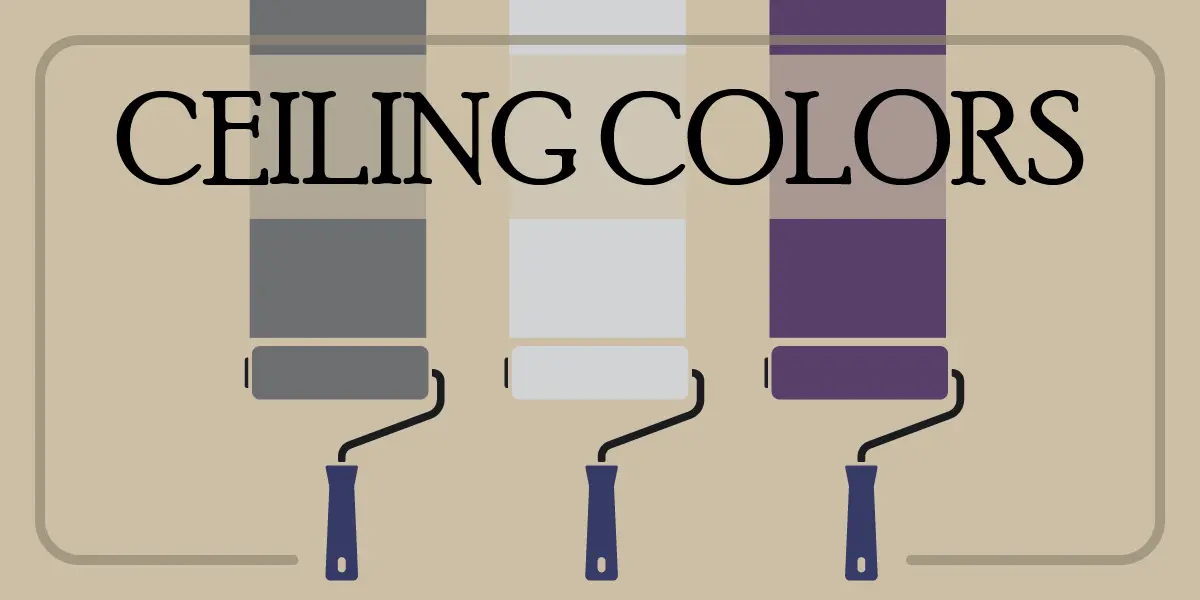Imagine you’re repainting the house.
You picked neutral gray for the living room, deep green for the dining room, bright yellow for the kids’ bedroom, and so on. But have you considered the ceilings?
A deep green ceiling in a deep green dining room might feel claustrophobic at best and soul-crushing at worst.
Ceilings are often overlooked in design, but the right paint color can transform a room for the better. The ceiling is your room’s “fifth wall,” and its color shapes the room’s mood, dimensions, and overall aesthetic.
Choosing Between Light & Dark Ceiling Paint
Light Paint for Ceilings
Light-colored ceilings expand a room. Shades like white, soft beige, or pale blue reflect light to create a spacious and airy feel.
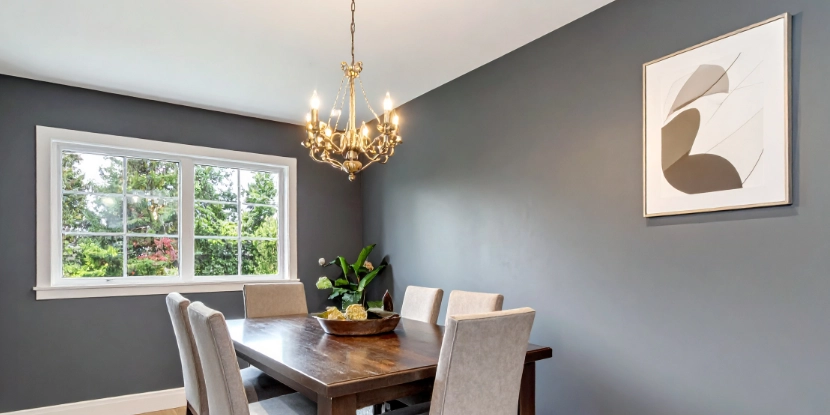
Light-colored ceilings open the room with reflected light.
Pros
- The illusion of height. Light hues make low ceilings appear taller.
- Light colors pair well with bold wall colors and prevent the room from “closing in.”
- Small or dark rooms feel brighter.
Best for
- Small rooms, like bathrooms or walk-in closets, to prevent a cramped feeling.
- Living or dining rooms with limited natural light.
Combinations to Try
- Classic: Soft white ceilings + navy or charcoal walls.
- Calming: Pale beige ceilings + deep green walls.
- Sophisticated: Off-white or cream ceilings + dark burgundy walls.
- Modern: Light gray ceilings + black or deep slate walls.
- Harmonious: Pastel blues + dark teal walls.
- Bold: Bright white ceilings + rich plum or royal blue walls.
Dark Paint for Ceilings
Dark ceilings are bold and dramatic but also intimate. Rich tones like charcoal, navy, or black add depth and make a statement.
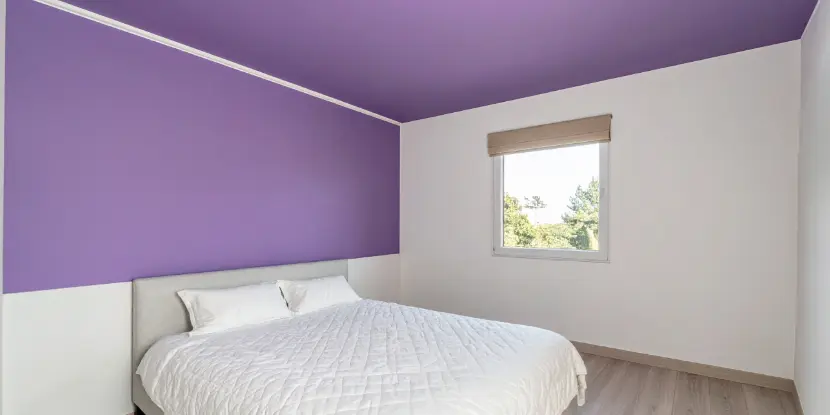
Need more excitement in the bedroom? Try a deep purple ceiling.
Pros
- Large spaces feel cozier and more inviting.
- Dark paint can disguise uneven textures or flaws in the ceiling.
- Dark hues exude elegance, especially in spaces with high ceilings.
Best for
- Dining rooms or bedrooms where you want to cultivate warmth and intimacy.
- Rooms with high ceilings to make them seem less cavernous.
Combinations to Try
- Classic: Cream walls + espresso ceiling.
- Contemporary: Dove-gray walls + charcoal ceiling.
- Glamorous: White walls + glossy black ceiling.
- Bohemian: Pale-pink walls + merlot ceiling.
- Industrial: Concrete walls + dark gray ceiling.
Should You Match the Ceiling to the Wall Color?
Matching Ceiling & Walls
Painting the ceiling and walls the same color (or a slightly lighter shade for the ceiling) creates a seamless look and a minimalist aesthetic.
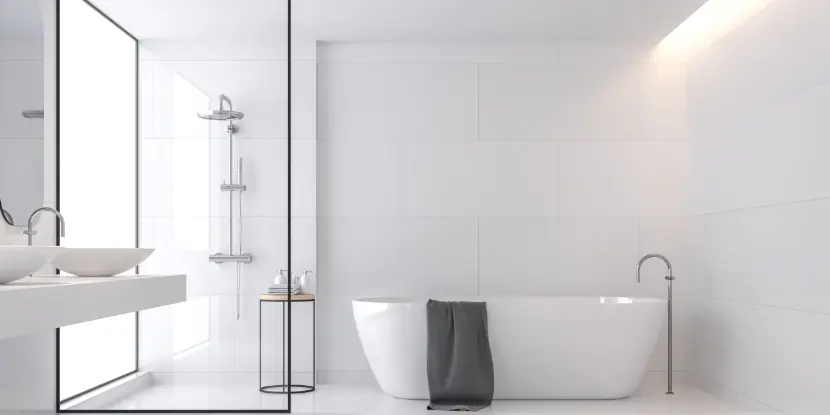
Painting the ceiling and walls the same color creates a seamless look and a minimalist aesthetic.
Pros
- Unifies the room.
- Can help small rooms feel cohesive rather than choppy.
- Works with both light and dark colors, depending on the desired mood.
Best for
- Compact spaces like powder rooms or hallways.
- Modern designs focused on simplicity.
Contrasting Ceiling Colors
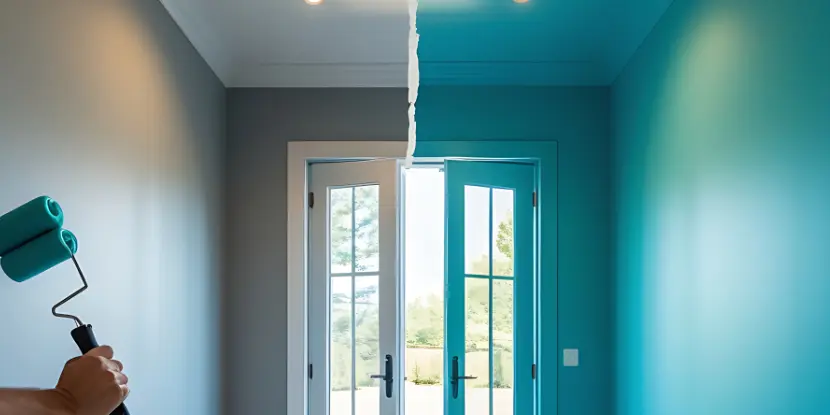
A non-matching ceiling color projects a more dynamic quality.
A non-matching ceiling color projects a more dynamic quality. For example, contrasting navy walls with a crisp white ceiling builds visual intrigue.
Pros
- Defines the ceiling as a design feature.
- Adds personality to otherwise neutral spaces.
- Allows you to play with bold color accents.
Best for
- Eclectic spaces like playrooms or edgy modern interiors.
- Spaces with prominent ceiling moldings or architectural details.
Which Paint Finish Is Best for Ceilings?
Your choice of paint finish will influence the look and mood of your ceiling almost as much as the color.
Matte Finish
Matte or flat finishes hide imperfections and reduce glare.
Pros
- Smooth, non-reflective surface.
- Mask flaws such as cracks or uneven textures.
Cons
- Can be difficult to clean.
- Not suitable for high-humidity areas.
Best for
- Standard home ceilings, particularly those with imperfections.
Eggshell Finish
Eggshell finishes have a soft sheen that reflects light and creates depth.
Pros
- Slightly reflective surface adds dimension.
- Easier to clean than a matte finish.
Cons
- May highlight imperfections in the ceiling.
- Not recommended for textured ceilings — it can lead to a patchy appearance.
Best for
- Homes with smooth, non-textured ceilings.
- Rooms that could use a bit of brightening up.
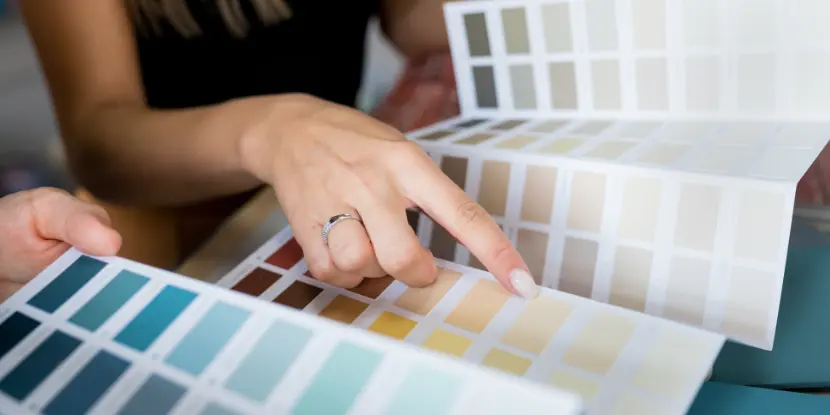
Customers browse a swatch guide to pick their paint colors.
Semi-Gloss Finish
Shiny semi-gloss finishes can open and illuminate a space.
Pros
- A highly reflective surface brightens the entire room.
- Durable and easy to clean.
Cons
- Can show every imperfection on the ceiling.
- May cause glare in rooms with lots of natural light.
Best for
- High traffic areas like hallways, kitchens, and bathrooms, where frequent cleaning is a fact of life.
- Rooms that should be bright and inviting, such as playrooms or living rooms.
Gloss Finish
Gloss finishes offer the highest level of shine. They create a sense of light and space.
Pros
- Maximum light reflection creates a bright and airy feel.
- Extremely durable and easy to clean.
Cons
- Can accentuate any flaws on the ceiling’s surface.
- May create unwanted glare in rooms with abundant natural light.
Best for
- Small spaces like bathrooms or closets, where a glossy finish can make a big impact.
- Rooms with minimal natural light that could use a lumen boost.
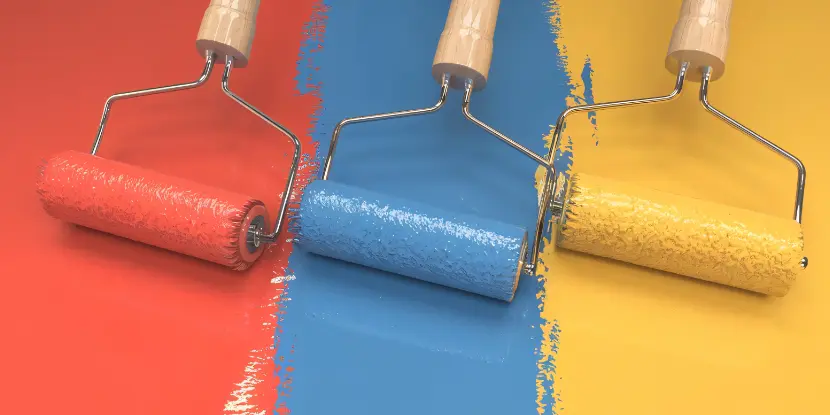
Your choice of finish — matte, semi-gloss, or gloss — has almost as much impact as the paint color.
Unique Considerations for Different Rooms
Bedrooms
Soft, pastel-colored ceilings like lavender or sky blue can promote a relaxing atmosphere. Pair them with neutral walls for a balanced look.
Kitchens
White or off-white ceilings work best to reflect light and make the space look clean and fresh. Consider a gloss finish for ease of cleaning, as kitchens are prone to grease and grime buildup.
Living Rooms
If your living room has high ceilings, a darker color can make the space feel warmer. A matte finish in a warm gray or muted green works well.
Bathrooms
Bathrooms often lack natural light. Light-colored ceilings combined with semi-gloss or gloss finishes brighten the space and resist moisture.
Home Offices
Choose lighter shades to keep the atmosphere bright, or try a calming color like sage green if natural light is abundant.
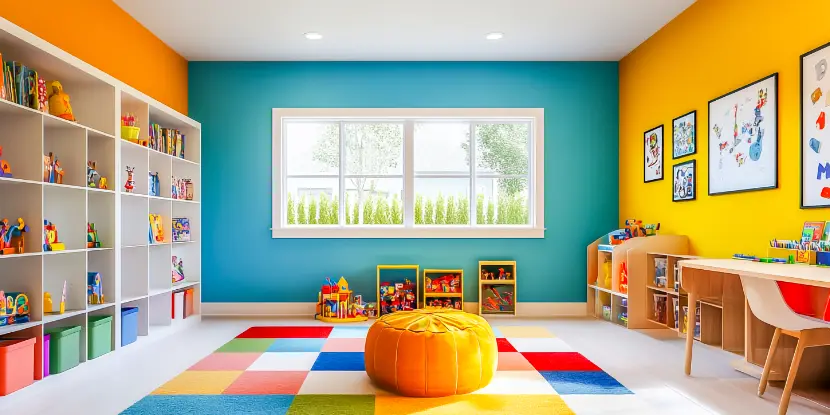
A neutral lets you take chances and be more adventurous with wall colors.
Tips & Tricks
- If you’re hesitant about painting the entire ceiling, try an accent color on one wall or in a small area, such as above a fireplace.
- Consider using metallic paints for added glamour and shine.
- Properly prime the ceiling before painting to ensure better coverage and adhesion of the paint.
- Use painter’s tape to create clean lines between the wall and ceiling.
- Don’t be afraid to experiment with bold or unexpected color combinations.
- Use a high-quality, thick paint to prevent drips and streaks.
- Paint the trim and door frames in a lighter color to create contrast.
FAQs: What Color to Paint a Ceiling
Q: What’s the most popular ceiling color?
White remains the most popular ceiling color due to its simplicity and versatility.
Q: Can I use wallpaper on the ceiling instead of paint?
Yes! Wallpaper is a bold choice for adding texture or patterns to the ceiling.
Q: When should I use dark paint for the ceiling?
Use dark paint in rooms with high ceilings or those where you desire drama and coziness.
Q: How do I handle textured ceilings?
Matte finishes work best as they mask imperfections and uneven textures.
Q: Are there eco-friendly paints for ceilings?
Low-VOC (Volatile Organic Compound) and water-based paints are good, environmentally friendly options.
Q: Can I paint my ceiling a bold color?
Yes. Bold ceiling colors can add personality, especially in eclectic or modern spaces.
Q: How often should ceilings be repainted?
Generally, ceilings need repainting every 7–10 years; more often if there’s significant wear or damage.
Q: Should I hire a professional to paint my ceiling?
Hiring a professional for large rooms, high ceilings, or intricate designs can ensure high-quality results.

